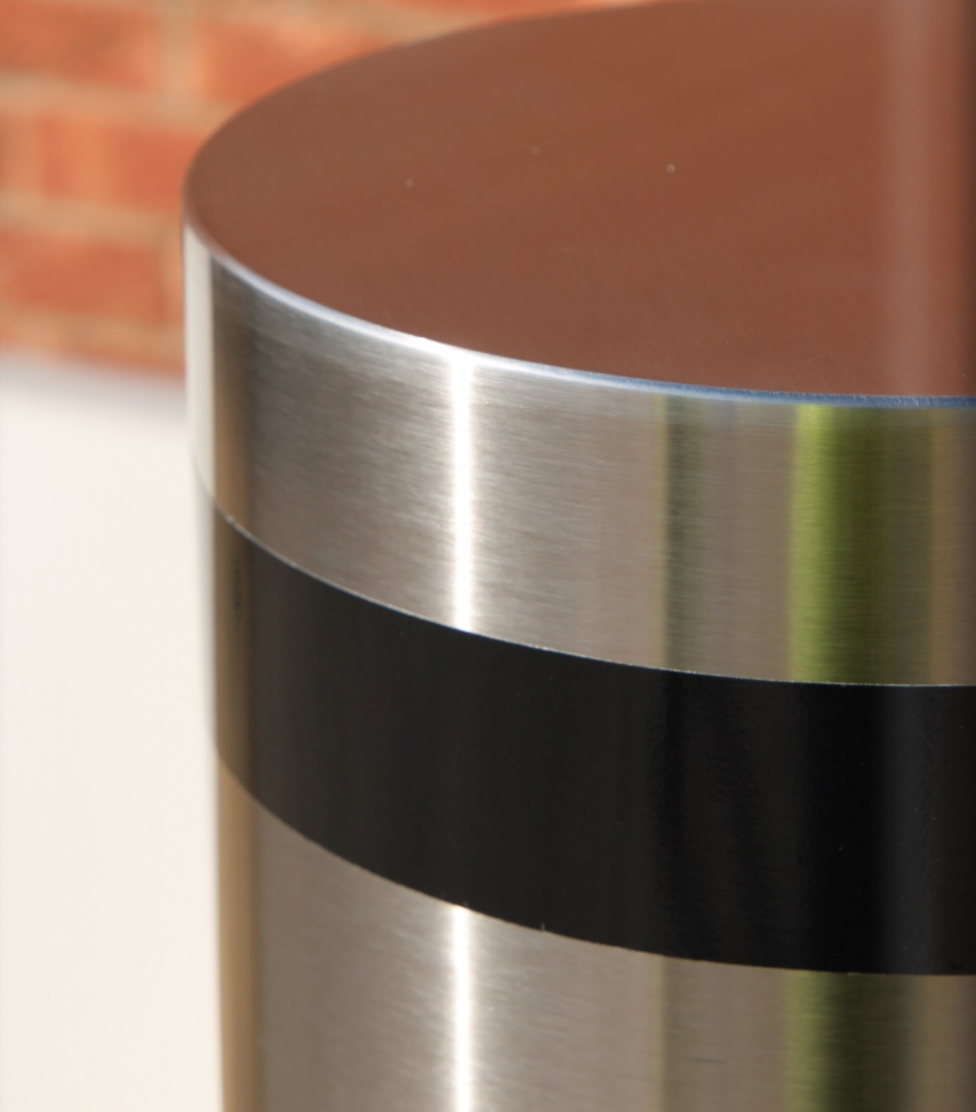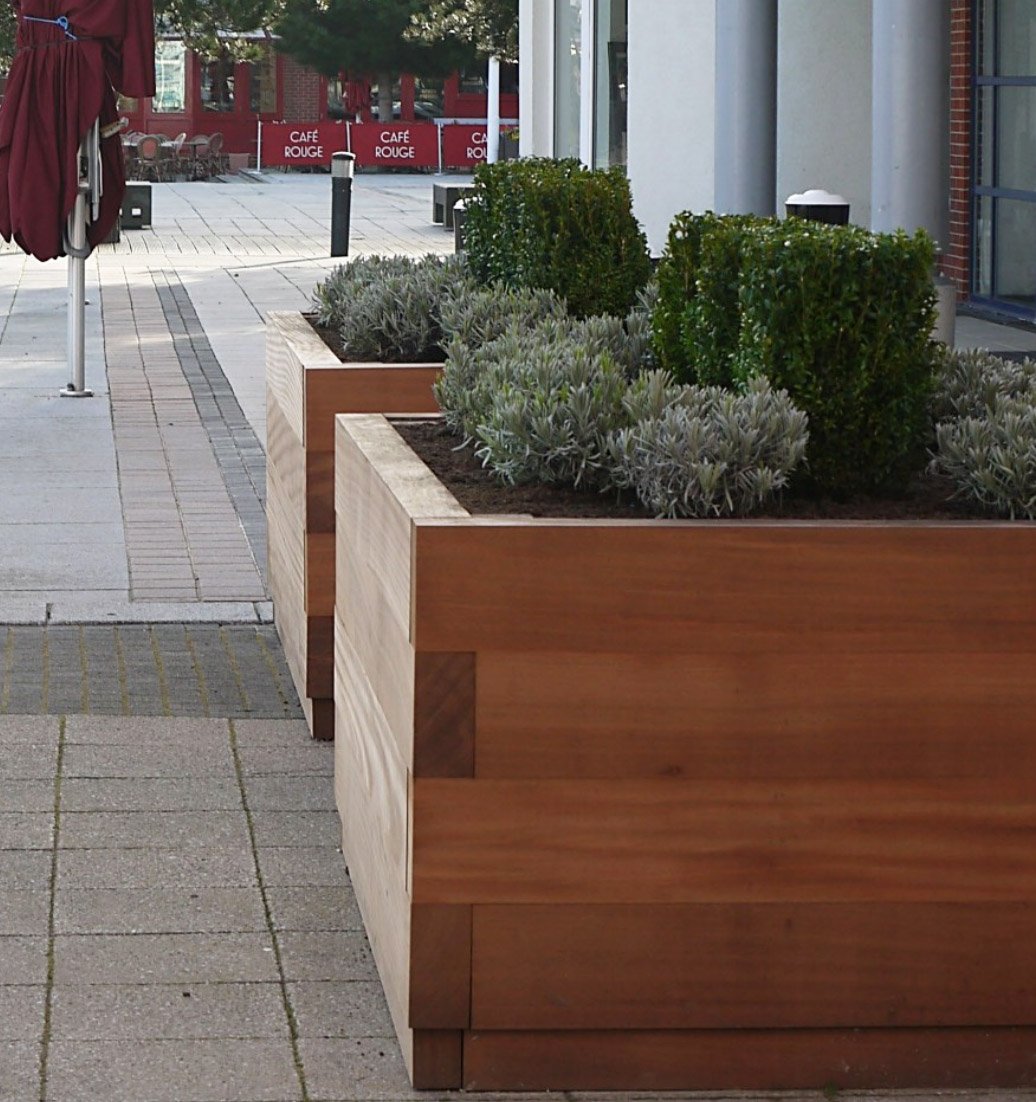Townscape Bollards
Townscape bollards have been supplied to designs that have been proven over 5 decades experience of development and installation. Bollards can be supplied in a number of different base materials to suit every situation and environment. So as to aid in ensuring the maximum life can be realised with the product, along with minimising the costs for major refurbishment.
The standards that have also been considered during the products manufacture are:
- BS EN ISO1461 – Galvanizing
- EN13438 – Powder Organic Coatings for Galv Steel
- BS EN ISO 13920 – Welding Tolerances Shapes, Dims and Lengths
- BS 6497 – Powder coatings for application to galv steel
- BS EN 206 – Concrete
Also view our PAS 68 Bollard range.

The timber used in the manufacture of bollards is used from a number of suppliers and importers and can be supplied from FSC if required. Hardwoods particularly English Oak are used as a bollard material as are many Softwoods including Douglas Fir (Both pressure treated and secondary process treated), however, due to its nature Timber has a tendency to move, surface crack, or split which is a feature of all timbers and does not look out of place in the informal environments in which these products are used and is not an indication of a product fault. Townscape has no control over the extent of cracking and splitting as timber is a natural material that is subject to movement. Please note some hardwoods – particularly Oak, Iroko and Opepe and other oily timbers can be subject the Tannin bleed. Tannin bleed, also known as tannin leaching or wood bleed, is a discoloration of a surface caused by tannins, natural organic compounds found in wood, migrating to the surface. This usually happens when moisture interacts with the tannins, causing them to leach out and create stains or discoloration. Townscape have no control of the extent of tannin bleed and its staining effect on porous materials. Tannin bleed is usually a slow leaching process but can under certain environmental conditions (e.g. high temperatures that cause the wood grain to open up followed by very heavy rainfall) can cause a very quick tannin discharge. Townscape pre wet treat oily hardwood to help to alleviate the effects. However as a naturally occurring process Townscape have no control over whether a batch of timber will be affected and to what degree. Tannin is an organic material what will – given time wash away from porous surfaces including concrete. For more direct tannin cleaning information please refer to the Townscape sales team. With care and an annual inspection and maintenance Timber products can provide many years of service.
Health and Safety information
The vast majority of products supplied/installed have no specific operating instructions once they have been installed. However, there is a need for certain Health and Safety notes to be followed at all times during their use and ongoing maintenance. These being:
- A product that is manufactured from cast iron, ductile iron, or concrete will be a significant weight. Therefore, the movement of such must not be undertaken by a single person. When reasonably practical, mechanical handling devices should be used for all products heavier than 20kg. Safety footwear should also be worn.
- When routine maintenance is being undertaken there is a requirement for the customer to observe the required Health and Safety Information for the materials/products being used. Townscape Products Ltd, identify that: It is the customer’s responsibility to ensure that full care, responsibility, correct operation/use, and training are adhered to at all times.
- Townscape cannot accept any responsibility for any damage or injury to persons or property as a result of not using the product in the proper, correct, and intended manner. Telescopic bollards are an exception and do have operating instructions for their ongoing use. In terms of Health and Safety, the main factor to consider is Manual Handling. When lifting/lowering a telescopic bollard the back should be kept straight and knees bent. Townscape does supply lift-assisted telescopic bollards. This consists of a gas strut fitted to the base of the bollard. The lift-assist system reduces the lifting weight by approx 75%, and therefore significantly reduces the risk of personal injury. When lifting / lowering telescopic bollards the manufacturer’s instructions should be followed at all times. When handling concrete bollards protective gloves should be worn at all times. This is to prevent abrasions and also to prevent skin contact with concrete dust. Concrete dust may cause irritation. On contact, hands should be washed with soap and water.
Townscape Precast Concrete Products
Cleaning of concrete is to retain the original finish and to remove unsightly deposits from the surface of the material. Light staining from food or liquid products should only be removed by an application of hot water with added detergent by a light brushing action. Heavier staining can be removed using proprietary cleaning products that are specifically manufactured for this purpose. Before any application the suitability and instruction for use should be obtained from the manufacturer, who will be able to offer specific advice and will normally carry out spot tests to ensure the precast concretes integrity after application. Jet washing, steam cleaning and blasting systems are available and may prove adequate if used by a competent operative. Intensive and localised use could erode the top surface. Acid cleaning of precast concrete on site is hazardous and should only be undertaken with the relevant precaution’s. Collection of debris from the surface area by all standard cleaning methods is acceptable. It is recommended that no severe cleaning action is carried out excessively; this includes harsh sucking action that may remove jointing materials, and the use of stiff bristled brushes that have repetitive action such as a circular scrubbing action that will both erode and mark the top surface. Care should be exercised in the use of heavy duty mechanical sweeping machines; these may cause damage through excessive scrubbing action and through scrubbing action of tyres. Contact Pieri U K Limited. Tel 01925 816095.
Concrete Discolouration
Townscape precast concrete products are manufactured using aggregates to create colour. In some instances, an additional dye may be added to a product to achieve a particular type of colour depth. Slight variations are to be expected from all naturally sourced materials and whilst we work very hard to alleviate colour variations it is an inevitable part of the ageing process. In the same way, slight variation in quarry seams may occur over a period of time.
Concrete Efflorescence
All concrete products may suffer the temporary phenomenon of efflorescence. This is in no way detrimental to the performance of the product. Its occurrence cannot be predicted, its occurrence is more probable in paving blocks than larger precast blocks.
Natural Aggregates
All Townscape Precast products are manufactured using natural aggregates sourced from sustainable sources.
Surface Micro Cracking
Whilst it is impossible to remove all surface cracking from precast concrete Townscape look to mediate surface Micro cracking through careful design of all the precast concrete elements to ensure this effect is kept to a minimum. Surface Micro cracking can occur at any time during the lifetime of the concrete and is generally limited to <0.5mm. in width. Micro cracking has no detrimental effect on the underlying concrete strength.
Rock Salt
Rock salt is a product frequently used for the elimination or prevention of ice and frost on paving. Rock salt is abrasive and continual use on precast products can cause deterioration of the surface. Alternative products in the form of granules or liquid can be used as an alternative. Granule forms known as Thaw Granules are available. Contact Dimex Limited. Tel. 0121 704 3551 Fax. 0121 704 4024.
Method for Maintaining Freeze-Thaw Affected Precast Concrete Products.
Clean away any affected loose concrete surface substrate with a stiff brush to ensure any flaking material is removed.
Patch repair the affected area if required. Townscape can provide a patch repair mix kit if needed.
Use a propriety concrete sealing system should as ‘Smith’s Polyurethane Paving Brick Sealer ‘or ‘Smith’s Permanent Concrete Sealer’ These type of sealing systems seals the surface of the concrete and are considered useful tools to help mitigate Freeze-thaw damage related issues.
Apply as directed by the sealer manufacturer.
Reapply the sealer in line with sealer manufacturers recommendations as part of your normal maintenance regimes.
Oil and Grease
Removal of oil from precast concrete.
In addition to hot water, an alkaline degreaser will greatly increase the removal rates of oil and grease. Hot water lifts the oil from the concrete, and the degreaser emulsifies the oil, allowing it to be flushed from the surface. Some contractors use at least a little degreaser for most jobs, even to remove dirt, which can be somewhat oily.
Rust
Rust will stain precast concrete. Particular care should be taken when using mild steel tools in the immediate vicinity of the concrete as the concrete can become contaminated with mild steel that will later appear as a rust stain.
Heavy rust stains can penetrate deeply into concrete, so they can be tough to remove completely. Cleaners containing oxalic acid are most effective.
Graffiti
Precast concrete with graffiti coating. Some of Townscape’s precast concrete products are treated with an anti-Graffiti coating. Please refer to the data sheets provided or refer to Townscape for maintenance and advice on cleaning.
General Graffiti
Graffiti can be very difficult to remove, depending on the type of paint used. Several proprietary chemical strippers are available, many of which contain a citrus-based solvent, methylene chloride, or potassium hydroxide. Citrus-based solvents are the least aggressive and may not work on certain Paints, but they are the safest to use and often have less-stringent disposal requirements. For best results, allow products containing potassium hydroxide to soak into the concrete surface for several hours before power washing. These products also require a subsequent application of an Acid Neutralizer. Graffiti also can be removed by a special attachment that includes a tungsten-carbide nozzle that meters sand into the water stream before it exits the nozzle. But the sand will etch the concrete, which may not be desirable. In recent years, softer sodium bicarbonate abrasives have been used with power washers to remove graffiti from concrete (see Concrete Construction, February 1999, p. 87).
Chewing Gum
Precast Concrete Contaminated with chewing gum.
For small areas contaminated by the careless disposal of chewing gum several “freeze spray” products are available. For large or heavily contaminated areas professional advice should be sought. Contact Blue Diamond Tel. 01703 629944 Fax. 01703 629771 or Kincora Tel. 0161 8737713 Fax. 0161 8480552 or Graffiti Magic Tel. 0115 9422052 Fax. 0115 9244683
Townscape Timber Products
Where wood has been used for the products purchased there are specific things that need to be taken into consideration regarding its use and performance.
The main points to note are that the assemblies will need some basic maintenance to get the maximum life from it to preserve its appearance and performance.

Hardwood Timber
A visual check should be completed at least every 3 months or more frequent whereby any splinters or sharp edges of wood are lightly sanded to remove them. This will ensure that any user of the product does not get injured.
Where timber has been supplied treated the wood should be coated with a proprietary wood stain to preserve its appearance and longevity. These are as below, which is dependent on wood supplied.
If the wood starts to deteriorate and its aesthetic value cannot be maintained, then it should be changed for a like for like replacement. Where replacement is made, then there will be shading difference against any wood that remains. This is due to the weathering effect of wood in service.
Tropical hardwood is exceptionally hard and resilient in its use. Townscape stain hardwoods with a system that maintains its appearance and ensures the best possible life for the product. If the tropical hardwood is not stained, then the surface will become a dull silver grey in colour. This has no detriment on the woods use and only affects the aesthetics of the finished product.
Timber as a natural material is subject to movement and cracking as it ages. As this is a naturally accruing phenomenon, Townscape has no control over the extent of cracking and splitting. However with care and an annual inspection Timber products can provide years of service.
Tannins in Hardwood timber and porous surface staining
Tannins are presence in all hardwood timber and are a natural part of the timber itself. It is stored within the internal Grains of the wood which, when water or moisture permeates through the timber, can sometimes bring these tannins to the surface causing black or brownish staining to nearby surfaces. Please note some hardwoods particularly Oak, Iroko and Opepe and other oily timbers can be subject the Tannin bleed. Tannin bleed, also known as tannin leaching or wood bleed, is a discoloration of a surface caused by tannins, natural organic compounds found in wood, migrating to the surface. This usually happens when moisture interacts with the tannins, causing them to leach out and create stains or discoloration. Townscape have not control of the extent of tannin bleed and its staining effect on porous materials. Tannin bleed is usually a slow leaching process but can under certain environmental conditions (e.g. high temperatures that cause the wood grain to open up followed by very heavy rainfall) can cause a very quick tannin discharge. Townscape pre wet treat oily hardwood can help to alleviate the effects. However as a naturally occurring process Townscape have no control over whether a batch of timber will be affected. Tannin is an organic material what will – given time wash away from porous surfaces including concrete. For more direct tannin cleaning information please refer to the Townscape sales team.

